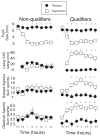Opioid abusers' ability to differentiate an opioid from placebo in laboratory challenge testing
- PMID: 23369645
- PMCID: PMC3911782
- DOI: 10.1016/j.drugalcdep.2013.01.001
Opioid abusers' ability to differentiate an opioid from placebo in laboratory challenge testing
Abstract
Background: Abuse liability assessments influence drug development, federal regulation, and clinical care. One suggested procedure to reduce variability of assessments is a qualification phase, which assesses whether study applicants adequately distinguish active drug from placebo; applicants failing to make this distinction are disqualified. The present analyses assessed differences between qualification phase qualifiers and non-qualifiers.
Methods: Data were collected from 23 completers of the qualification phase of an abuse liability study. Opioid abusing participants received 30 mg oxycodone and placebo orally on separate days, and were characterized as qualifiers (vs. non-qualifiers) if their peak visual analog scale liking rating for oxycodone was at least 20 points higher than placebo's peak rating. Groups were compared on demographic characteristics, drug history, and physiologic, subject and observer ratings.
Results: 61% of participants were qualifiers and 39% were non-qualifiers. Groups had similar demographic characteristics, drug use histories, and pupillary constriction responses. However, unlike qualifiers, non-qualifiers had an exaggerated placebo response for the liking score (p=0.03) and an attenuated oxycodone response for the liking score (p<0.0001). Non-qualifiers' failure to differentiate oxycodone versus placebo was evident for subject and observer ratings.
Conclusion: Different subjective responses to identical stimuli support the use of a qualification phase in abuse liability assessments. Further research should explore objective measures that may better account for these differences, determine optimal qualification criteria, and explore the developmental course of drug use. This study also documents certain opioid abusers fail to differentiate 30 mg of oxycodone from placebo, a phenomenon deserving further study.
Keywords: Abuse liability; Discrimination; Opioids; Placebo; Qualification.
Copyright © 2013 Elsevier Ireland Ltd. All rights reserved.
Figures
References
-
- Balster RL, Bigelow GE. Guidelines and methodological reviews concerning drug abuse liability assessment. Drug Alcohol Depend. 2003;70:S13–S40. - PubMed
-
- Busto UE, Zawertailo LA, Kaplan HL, Sellers EM. Identifying appropriate subjects for abuse liability studies using prestudy pharmacological testing. Can J Clin Pharmacol. 1999;6:103–110. - PubMed
-
- Center for Drug Evaluation and Research (CDER) Guidance for Industry: Assessment of Abuse Potential of Drugs. Center for Drug Evaluation and Research, Food and Drug Administration; Rockville, Maryland 20852: 2010. pp. 13–14.
-
- De Wit H, Griffiths R. Testing the abuse liability of anxiolytic and hypnotic drugs in humans. Drug Alcohol Depend. 1991;28:83–111. - PubMed
Publication types
MeSH terms
Substances
Grants and funding
LinkOut - more resources
Full Text Sources
Other Literature Sources
Medical


